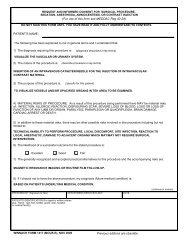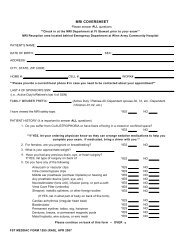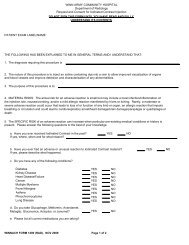[View] Army Vision Readiness Guidelines and Standards
[View] Army Vision Readiness Guidelines and Standards
[View] Army Vision Readiness Guidelines and Standards
You also want an ePaper? Increase the reach of your titles
YUMPU automatically turns print PDFs into web optimized ePapers that Google loves.
VISION READINESS<br />
CLASSIFICATION SYSTEM<br />
(VRCS)
Ensure Soldiers are visually<br />
<strong>and</strong> optically ready for<br />
deployment to maximize<br />
combat effectiveness <strong>and</strong><br />
safety
• A tool for comm<strong>and</strong>er’s to verify <strong>and</strong> track the vision readiness of<br />
their unit<br />
• Ensures the Soldier’s ability to see<br />
• Validates the possession of optical devices required for deployment<br />
• Reduces surge to Optometry when deployment window is short<br />
• Reduces surge on Optical Fabrication Enterprise to fabricate <strong>and</strong><br />
deliver optical devices on a short suspense<br />
• Saves money by reducing duplicate orders <strong>and</strong> outsourcing<br />
• Can <strong>and</strong> should be conducted by the unit at any time<br />
• Annual requirement<br />
• Easy <strong>and</strong> quick to perform on incoming Soldiers
<strong>Vision</strong> readiness is a<br />
responsibility.<br />
The purpose of this guide is to assist<br />
unit screeners in performing the<br />
vision readiness screening <strong>and</strong> to<br />
guide MEDPROS users in recording<br />
vision readiness data in MEDPROS<br />
We are always here to assist!
CONTACT LENSES SHOULD<br />
WORN DURING TESTING<br />
BE<br />
Per DA PAM 40-506, The <strong>Army</strong> <strong>Vision</strong><br />
Conservation <strong>and</strong> <strong>Readiness</strong> Program:<br />
“Contact lenses WILL NOT BE worn<br />
during basic training, field exercises, gas<br />
chamber exercises, DEPLOYMENTS,<br />
OR COMBAT”
• Class 1: Soldiers whose bestcorrected<br />
visual acuity is<br />
better while looking at the<br />
appropriate chart<br />
with .<br />
or<br />
• Additionally, to be Class 1, the<br />
Soldier must possess all<br />
.
Those requiring prescription<br />
eyewear:<br />
‣ 1 pair of eyewear<br />
‣ 1 pair of MCEP<br />
‣ 1 pair of MCEP inserts<br />
‣ 1 pair of promask inserts<br />
Those not requiring prescriptions<br />
eyewear:<br />
‣ 1 pair of MCEP
AUTHORIZED<br />
PROTECTIVE<br />
EYEWEAR<br />
LIST (APEL)<br />
APPROVED
• Class 2: Soldiers whose best-corrected<br />
visual acuity is<br />
while looking at the<br />
appropriate chart with<br />
. Additionally, they must possess<br />
all required optical devices.<br />
• Also includes individuals possessing a<br />
waiver for binocular visual acuity<br />
worse than 20/40. No corrective action<br />
is required.
Soldiers who are<br />
:<br />
Class 3-O: Not optically ready. Soldiers<br />
whose<br />
or<br />
better,<br />
.<br />
‣ Refer to Optometry to order more glasses<br />
Class 3-V: Not visually ready. Soldiers whose<br />
best-corrected vision is<br />
<strong>and</strong><br />
do not<br />
meet vision st<strong>and</strong>ards.<br />
‣ Refer to Optometry for an eye exam
• Class 4: Soldiers who have not<br />
been screened within one year.<br />
<strong>Vision</strong> readiness screening is<br />
required.
Must meet this st<strong>and</strong>ard being tested<br />
on<br />
both near <strong>and</strong> far charts.<br />
The worse performance at<br />
distance<br />
or near governs the class<br />
determination
DISTANCE: 20 ft, normal<br />
lighting<br />
NEAR: 16 in or normal reading<br />
distance, normal lighting, place on<br />
clip board
<strong>Vision</strong> Group<br />
1<br />
<strong>Vision</strong> Group<br />
2<br />
<strong>Vision</strong><br />
Group 3 is<br />
unable to<br />
read any<br />
lines on<br />
this chart
Without Glasses: read the smallest line<br />
of letters possible with BOTH eyes<br />
open.<br />
CLASS 1 (GO): 20/20 (with or without glasses)<br />
CLASS 2 (GO): 20/40 (with or without glasses)<br />
If the soldier is unable to read the 20/40<br />
line<br />
correctly with their glasses OFF, then<br />
re-test<br />
the Soldier with their glasses ON.
If the soldier is still unable to read the<br />
20/40<br />
line or better, OR if they don’t have all<br />
the<br />
required glasses, they are:<br />
CLASS 3 (NO-GO):<br />
CLASS 3 O: means they don’t have all<br />
the glasses required soldier needs to<br />
order more glasses<br />
CLASS 3 V: means they don’t see 20/40<br />
or better with their glasses soldier<br />
needs an eye EXAM
For Soldiers<br />
, repeat<br />
the<br />
testing from step 1 with the smaller eye<br />
chart at near<br />
Side note: if the Soldier had to wear<br />
glasses to pass the test at 20 feet, then<br />
they must wear the same pair of glasse<br />
when being tested at 16 inches.<br />
: The worse performance at distance<br />
or near governs the Class determination
Soldiers that are<br />
.<br />
Soldiers that are class 3(O or V) or<br />
class 4 are non-deployable.<br />
Soldiers in Class 3 or 4 at the time of<br />
screening will immediately be<br />
reclassified in MEDPROS after<br />
obtaining corrective vision/optical<br />
services.
• All Soldiers are Screened<br />
• Information has been recorded on Unit <strong>Vision</strong><br />
<strong>Readiness</strong> Screening Sheet<br />
• All Class 3’s have been sent to Optometry<br />
▪ Class 3-V for exams<br />
▪ Class 3-O to reorder eyewear<br />
• Class 2’s have been recommended to go to<br />
Optometry<br />
• MCEP has been ordered by the Unit<br />
• Those needing MCEP Inserts have been sent to<br />
Optometry
Yongsan, Korea<br />
Sharon Quigley<br />
011(822)795-7230<br />
FT Lewis, WA<br />
Don Mellor<br />
(253)968-4486<br />
Heidelberg, GE<br />
Delois Klemm (GS)<br />
+49(622)117-2629<br />
FT Carson, CO<br />
Tim Durbin<br />
(719)524-4520<br />
FT Hood, TX<br />
Stacey Daniels<br />
(254)286-7235<br />
FT Benning, GA<br />
Cynthia Borel<br />
(706)545-7349<br />
Walter Reed AMC<br />
Steddy Primus<br />
(202)782-3301<br />
FT Bragg, NC<br />
Tammy Huddleston<br />
(910)396-3103<br />
FT Campbell, KY<br />
Lewis Long<br />
(270)956-0451<br />
Tripler AMC, HI<br />
Steve Burton<br />
(808)433-1915<br />
FT Sam Houston, TX<br />
Audrey Luken<br />
(210)295-2503<br />
FT Stewart, GA<br />
Tawanna Campbell<br />
(912)435-5296<br />
FT Gordon, GA<br />
Mike Burley<br />
(706)787-0613
• Continue data entry until all Soldiers are<br />
updated<br />
• Screening can be conducted at any time<br />
• SRP’s<br />
• After PT Test<br />
• When new Soldiers report to unit<br />
• During Soldiers’ birth month<br />
• After m<strong>and</strong>atory training<br />
• It is easier to screen Soldiers <strong>and</strong> do the<br />
MEDPROS entry on an individual basis than to<br />
do an entire unit at one time
• The VRCS is a Comm<strong>and</strong>er’s Tool<br />
• Verifies that Soldiers can see<br />
• Verifies they have the devices they need to deploy<br />
• Most Soldiers listed as Non-Deployable have<br />
not been screened<br />
• Therefore the comm<strong>and</strong>er does not know the<br />
<strong>Readiness</strong> of that Soldier<br />
• Eye doctors <strong>and</strong> optical fabrication may not be<br />
available in the area of deployment<br />
• VRCS is a PROACTIVE readiness solution


![[View] Army Vision Readiness Guidelines and Standards](https://img.yumpu.com/38609565/1/500x640/view-army-vision-readiness-guidelines-and-standards.jpg)













